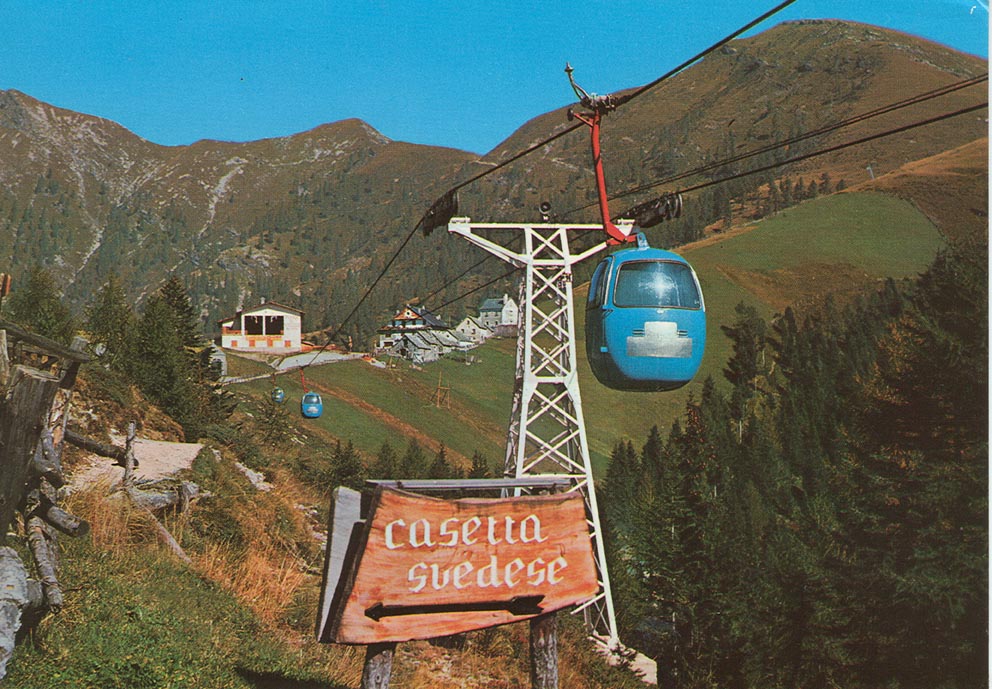
The Port Vell Aerial Tramway in Barecelona is built with Bleichert’s dodecagonal (12-sided) cabin. Image by Jordiferrer.
Many modern urban ropeways and their manufacturers are easily recognizable based purely from their cabin designs.
For instance, monocable detachable gondolas (MDGs) built by Doppelmayr use the OMEGA carriers from CWA while the Leitner Group (Leitner ropeways and Poma) uses the Diamond cabins from Sigma. However, before the industry experienced a flurry of mergers at/near the turn of the 20th century, many smaller ropeways manufacturers expertly plied their craft around the world.
Not so dissimilar to some of the iconic cabin models we see today, many prominent ropeway builders of the past were also easily recognizable based solely on their carrier designs.
With the return of the custom-built “Charlotte” cabin on the Brest Cable Car this week and the continued growth in cable transit, we thought it would be interesting to showcase a few nostalgic cabin types that are practically unknown to the outside world.
As ropeway companies and planners are becoming increasingly sensitive to the importance of aesthetics in the urban environment, perhaps some of these images will inspire cities to add a little more flavour and personality to their cabin designs.
Gerhard Müller Dietlikon (GMD) — Lightweight Aluminum Cabins

Emmetten-Stockhütte Gondola (1968) was built with Müller’s iconic aluminum 4-person cabins. Image from Seilbahn-Nostalgie.

The steel lattice hanger arms were another unique feature of the Muller gondola design. Image from Seilbahn-Nostalgie.
Gerhard Müller was a Swiss engineer and one of the pioneers in detachable ropeway technology. As the founder of Gerhard Müller Dietlikon (GMD) in 1947, he was one of the most important players in the production of aerial lifts until his death in 1985.
Among his many accomplishments, he was known for designing lifts with portal/gantry towers, inventing the detachable Müller grip and inventing the ill-fated Aerobus. In addition to his great technical achievements, many of Müller’s ropeways were immediately identifiable by spotting its lightweight aluminum cabins.
More than twenty of these gondola systems were built throughout the world but many, if not most, of them have been modernized.
Carlevaro & Savio — Futuristic / Egg-Shaped Cabins

Piana di Vigezzo gondola (1986) built with the iconic egg-shaped cabins. Most of the cabins were designed to fit 2-4 persons. Image from chairlift.org.

UFO-style cabin at Mount Snow, Vermont. Very little information is available about this system. Image from Colorado School of Mines.
Carlevaro & Savio was an Italian ropeway company that was founded in 1945.
They were recognized for designing their lifts with charming egg-shaped cabins made of metal and fibre glass. Many in the industry considered Carlevaro & Savio’s designs as some of the most futuristic-looking ropeways for their time. Dozens of these systems were built around the world in countries such as the USA, Italy, Switzerland and France.
Aside from their whimsical gondola cabins, they were also one of the first companies to develop a detachable grip. Their spring-loaded clamp is considered the forerunner of the detachable grips now used by Doppelmayr and Leitner ropeways.
Von Roll — Side-Chairs

The Krupka-Mückentürmchen sidechair (Czech Republic), built in 1952, is still operational today! Note that the chair has a roof for weather protection. Image form Seilbahn-Nostalgie.

VR 101 sidechair constructed for the 1949 KABA Expo in Thun, Switzerland. System carried 300,000 riders. Image from R. Von Roll.
Voll Roll, a Swiss ropeway manufacturer based in Bern, was another prolific builder of ropeways.
They were famous for being the inventors of the detachable chairlift, the VR101 model, way back in 1945. They were similarly well-known for designing 2-seater side chairs where passengers actually sat perpendicular to their direction of travel. This might seem a little odd nowadays, but from what we can gather online, the sideway seating was believed to provide passengers with a better ride and viewing experience. Also, the sideway profile of the chairs meant that station widths could be reduced.
While the chair is not a “cabin” per say, sidechairs do provide an example of the unique carrier designs that were once found on passenger ropeways.
Bleichert — Dodecagonal, 12-Sided Cabin

Predigtstuhl Cable Car (1928) is the oldest, still operational, large-cabin cable car on the planet. It connects a 1613m tall mountain in southern Germany. Image by HUvB.

The Aeri de Montserrat (Spain) opened in 1930 and still operates with its original cabins. The 1.3km system links visitors to the Monserrat Mountain near Barcelona. with Image by HuvB.
Established in 1874, Bleichert was once the world’s largest ropeway manufacturer, having built thousands of cable lifts on every corner of the globe.
While it initially focused its efforts on constructing material transport ropeways, it began to build iconic passenger lifts after World War I. Some famous systems include the Tyrolean Zugspitze Cable Car (formerly highest altitude), Predigstuhl Cable Car (oldest operating cable car with original cabin, 1928), and Port Vell Aerial Tramway (formerly highest ropeway tower, 107m).
Despite the age of some of Bleichert’s systems, it appears that some systems still operate with the original cabins built almost 100 years ago! As you might be able to tell from the photos above, the 12-sided dodecagonal cabins which fit 20-35 persons were a instantly recognizable symbol of Bleichert’s aerial tram products.
The aforementioned images and videos really just scratch the surface of the diversity found in the historical ropeway carrier scene. Given the dozens of cable car companies in the past and thousands of installations worldwide, let us know below in the comments section which nostalgic cabin designs are your favourite.
